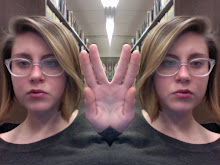“Telephone,” Gaga’s most recent experimentation with the limits of the music video, pays homage to Quentin Tarentino’s kitsch-memorabilia aesthetic. Gaga’s second collaboration with “Paparazzi” music video director Jonas Akerland runs nine and a half minutes and has a tendency to frustrate viewers, including myself, in its evasion of a simple evaluation.
The video’s length, combined with the schizophrenic pacing, makes for a viewing experience that actively interrupts the flow of the song. A song and its music video are typically in tandem. The images presented exist within the pacing and the time frame of the song. In Gaga’s videos, however, the video and the song are in competition with one another, with the visuals sometimes beating the songs senseless. “Telephone” breaks the neatly compacted nature of the music video format; it's essentially a short film with a single song featured prominently, like one of the many product placements that fill Gaga videos.
The visuals in "Telephone" are completely overwhelming, running the gamut of free association. From Madonna to 70's smut to pastel-colored Japanese video games ("Cooking Mama" comes to mind), "Telephone" packs an impossibly large picture of both obscure and mainstream pop culture moments into nine minutes or so. The real question, of course, is weather or not this exercise works.
Because the video contains so many references, it encourages a sort of pop culture "Where's Waldo" approach to viewing the video (for an excellent example of this approach to viewing the video, see this feature at MTV.com). On my first several encounters with the video, I couldn’t get past the endless references. I immediately dismissed it as an unfortunately experiment with the kitschy, tounge-in-cheek smugness that marks Tarentino’s later films, an attitude that is entirely unproductive for any sort of intelligent cultural critique.
My outright dismissal of “Telephone,” however, struck me as too simplistic, not only because I’m a Gaga fan, but also because the video is actually fun to watch, once you allow it space to run without judging it too strongly. If the “Paparrazzi” video twists and inverts Sunset Boulevard’s violent film noir elements, then “Telephone” plays free association with the perverse plot developments that structure the iconic B-movies of the sixties and seventies, such as Faster Pussycat, Kill, Kill! (which is, incidentally, one of the inspirations for Tarentino’s half of the slap-happy Grindhouse double feature, Death Proof) and Caged Heat. Events unfold in these films at a hectic pace, every element, from the costumes to the props to the acting trying to one-up the other elements in the film. The editing and plot of these films necessitate an audience that doesn’t mind being battered senseless with a plethora of ridiculous stimuli; in fact, that’s usually part of the fun.
My outright dismissal of “Telephone,” however, struck me as too simplistic, not only because I’m a Gaga fan, but also because the video is actually fun to watch, once you allow it space to run without judging it too strongly. If the “Paparrazzi” video twists and inverts Sunset Boulevard’s violent film noir elements, then “Telephone” plays free association with the perverse plot developments that structure the iconic B-movies of the sixties and seventies, such as Faster Pussycat, Kill, Kill! (which is, incidentally, one of the inspirations for Tarentino’s half of the slap-happy Grindhouse double feature, Death Proof) and Caged Heat. Events unfold in these films at a hectic pace, every element, from the costumes to the props to the acting trying to one-up the other elements in the film. The editing and plot of these films necessitate an audience that doesn’t mind being battered senseless with a plethora of ridiculous stimuli; in fact, that’s usually part of the fun.
In “Telephone,” product placements, costumes, and visual references to pop culture artifacts congeal into a visual mess of fast cuts and even faster set changes. What is so remarkable about the video is its relentless pace; even when the song is not dominating the soundtrack, the video moves quickly, creating an complex interplay Tarentino-influenced dialogue and wonky visuals. If a music video could be a ride, “Telephone” would be a roller coaster.
Because the “Telephone” video isn’t really about the music, it’s easy to write off as self-indulgent ego stroking. It’s this tension between the visuals and the music that characterizes any music video. Why do we actually need these visuals? If the song is good, why bother mixing it up in a video where it might get lost among a whole slew of stimuli? I think that it is exactly this tension that “Telephone” questions very seriously. It is obvious to any viewer that the song and the video have almost nothing to do with each other, which points the absurdity of making these videos in the first place. And yet, it’s this space of free association between the video and the song that makes “Telephone” better than it is as a song.





No comments:
Post a Comment